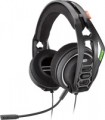Console compatibility
License binding of headphones to a specific model of the game console means full
compatibility between devices and gives a 100% guarantee that all claimed functions will work. Note that in addition to the stated set-top box, such headphones can be safely used in conjunction with a computer, smartphone and other models of game consoles through suitable connection interfaces. However, the full potential of the headphones is revealed only in conjunction with a certain game console.
Cable length
The length of the cable supplied with the headphones with the appropriate connectivity.
The optimal cable length depends on the planned format of the "ears". So, for pocket gadgets,
1 metre or less is often enough, for a computer it is already desirable to have a wire for
1 – 2 m, and preferably
2 – 3 m. And models with a longer cable length —
3 – 5 m or even
more — are mainly designed for specific tasks, such as connecting to a TV or using in recording studios.
Recall that in some models the cable is removable (see below) and can be replaced if necessary with a longer or shorter one. Also note that there are extension cables that allow you to increase the length of the main wire; such a cable may even be included in the delivery, this point (and the length of the additional cable) is usually specified in the notes.
Microphone noise canceling
The presence of a noise reduction system in its own headphone microphone.
In accordance with the name, such a system is designed to eliminate extraneous noise - primarily during conversations. It is usually based on an electronic filter that passes the sound of a human voice and cuts off background sounds such as city noise, the rumble of wind in the microphone grille, etc. As a result, even in noisy environments, thanks to the
noise reduction of the microphone, speech is clear and intelligible; True, the system inevitably introduces distortions into the final sound, but they are not critical in this case.
— ENC. ENC (Environment Noise Cancellation) technology significantly reduces ambient noise with directional microphones. It is used both in gaming devices so that gamers can easily communicate in voice chat, and in TWS earphone models so that you can comfortably talk on the phone in a noisy environment.
— cVc. Microphone noise reduction cVc (Clear Voice Capture) is an advanced technology that is found mainly in expensive headphone models. cVc algorithms effectively suppress echo and noise from the environment. Sound processing using this technology is carried out at several levels at once - the algorithm determines the reference signal-to-noise level, automatically adjusts speech to the desired volume level, applies adaptive equalizers to process the entire voice, as well as specialized filters to remove
...low-frequency bubbling, sibilants and hissing.Weight
The total weight of the headphones; for true wireless models (see "Cable Type"), the weight of each individual earbud is listed.
This parameter is directly related to the design (see above) and some features of the functionality. Thus, the mentioned true wireless devices are very light, their weight
does not exceed 25 g. More traditional in-ears and in-ears can be noticeably heavier,
up to 50g for in-ears and up
to 100g for most in-ears. Overhead models, for the most part, are quite massive: among them there are many models weighing
200 – 250 g,
250 – 300 g and even
more than 300 g. It should be noted that a significant weight for false ears is often not a disadvantage, but an advantage: it allows them to stay on the head more securely, creates an impression of solidity and reliability, and most often does not create significant inconvenience.

